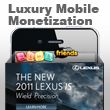By Amy Vale
 What’s the first thing that comes to mind when you think
of the word “luxury”? For me, it’s usually exquisite craftsmanship, beauty,
privilege and a sense of exclusivity. Wealthy Americans, better known as that
group of consumers earning a minimum of $150,000 a year, are apt to use their mobile
devices for all kinds of activities associated with the purchase funnel.
According to a study by The Luxury Institute and Plastic Mobile, 60% of wealthy Americans owned a smartphone, of which more
than 80% had downloaded an app. The study goes on to show that mobile luxury
shoppers are most interested in using apps to gain access to discounts. 46% of
those who had downloaded or planned to download any mobile app said they
expected a luxury app to provide them with a loyalty program. Early access to
sales was the second-highest anticipated app feature, at 45%. For publishers
and app developers, understanding these consumer perceptions will go a long way
in serving up mobile advertisements onto smartphones and tablets that are
relevant, engaging and, most importantly, deliver consistent revenue. Now,
let’s look at three ways luxury publishers and app developers can maximize
their monetization strategies.
What’s the first thing that comes to mind when you think
of the word “luxury”? For me, it’s usually exquisite craftsmanship, beauty,
privilege and a sense of exclusivity. Wealthy Americans, better known as that
group of consumers earning a minimum of $150,000 a year, are apt to use their mobile
devices for all kinds of activities associated with the purchase funnel.
According to a study by The Luxury Institute and Plastic Mobile, 60% of wealthy Americans owned a smartphone, of which more
than 80% had downloaded an app. The study goes on to show that mobile luxury
shoppers are most interested in using apps to gain access to discounts. 46% of
those who had downloaded or planned to download any mobile app said they
expected a luxury app to provide them with a loyalty program. Early access to
sales was the second-highest anticipated app feature, at 45%. For publishers
and app developers, understanding these consumer perceptions will go a long way
in serving up mobile advertisements onto smartphones and tablets that are
relevant, engaging and, most importantly, deliver consistent revenue. Now,
let’s look at three ways luxury publishers and app developers can maximize
their monetization strategies.
Integrate banner
ads into mobile-optimized luxury sites
The biggest benefit of a mobile-optimized site is that it
can be used in conjunction with many mobile functions. So understand the type
of ad content that will appeal and resonate with luxury mobile shoppers. For
example, don’t try to do too many things with mobile banner ads. Less is more.
Focus on one clear call-to-action that will increase clicks, downloads and
eventually revenue. By doing so, publishers and app developers will be well on
their way to monetization.
Deliver
exclusivity via “insider access”
Luxury connotes a sense of exclusivity and “insider
access.” Leverage that quality by serving mobile ads with exclusive content via
rich media and mobile video. By serving mobile ads that are entertaining,
engaging and, most importantly, let mobile luxury shoppers experience “never
seen before” content will be an effective monetization strategy for publishers
and app developers. In the case of luxury carmaker LandRover, video has proven to be a key piece of their mobile-focused advertising
strategy. During the pre-launch of its 2012 Range Rover Evoque, Land Rover
introduced a mobile app called Pulse of the City and also created an
interactive online movie in hopes of entertaining and informing its
early-adopter, tech-savvy target audience.
Leverage
“appvertising” within gaming apps
Earlier this year, Juniper Research released its “MobileAdvertising: Messaging, In-App and Mobile Internet Strategies 2012-2017” report
highlighting what brands are doing well, and not so well, to monetize apps and
mobile sites. The report projects that in-app mobile advertising spend will
reach $10.4 billion by 2017. Clearly, apps aren’t going anywhere any time soon,
so understanding where, when and how to serve up mobile ads within apps is most
important for publishers and app developers right now. One tactic to create a
consistent funnel of revenue for app developers is to deliver ads within gaming
apps. As recently as a few weeks ago, Toyota’s luxury brand Lexus hedged its
mobile bets on video ads
within the gaming app Gems With Friends. Video
ads of the new Lexus ES model are served to Gems
With Friends players, and then connect Gems
With Friends players to the Lexus Facebook page. What’s important to
understand is that not every gaming app will be the right place for publishers
and app developers to serve up ads. Figuring out the right time, the right
place and the right message will make monetization feel much more attainable
for app developers.


 There are over 40,000 health and fitness apps out there, and that number is climbing fast. Not to mention, these healthy apps are expected to bring in $1.3 billion in 2012, according to a
There are over 40,000 health and fitness apps out there, and that number is climbing fast. Not to mention, these healthy apps are expected to bring in $1.3 billion in 2012, according to a